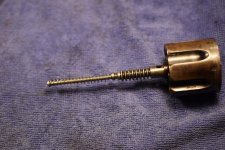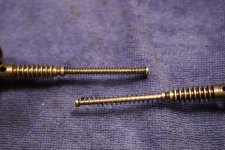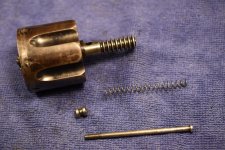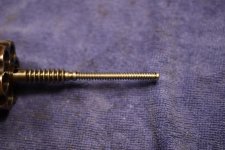- Joined
- Dec 1, 2022
- Messages
- 862
- Reaction score
- 1,403
Hi There,
Well, this same early No. 3 always acted anemic when it came
to the return of the extractor after extraction. Almost always,
I would have to help it by pushing down with my finger.
Initially, I wasn't sure what the problem was but after collecting
a couple more no. 3's, I can see the spring isn't right. The cur-
rent spring was made from .018" wire and only has 19 turns
(plus its diameter is larger than the others in my collection).
Measurements of the springs from other no. 3's shows me that
the wire should be .027" in diameter and have 31 coils. The
outside diameter of the spring varies from .200" to .202" de-
pending on which example I measure. It took me some time
to get the correct pitch but I found .069" to work well.
I couldn't find music (piano) wire exactly .027" in diameter
but .026" was a standard size, so I went with that.
The biggest problem (for me) is to determine the correct dia-
meter mandrel for winding the wire around to get the correct
diameter spring. It isn't quite as straight forward as one might
think.
One might think that If one wants a .200" diameter spring,
and the wire is .026" in diameter, well then .200 - ( 2 X .026 )
= .148" mandrel would be right size, but it isn't. You see, the
coiling of the spring using music wire (which is a high carbon,
high tensile strength steel wire), there is going to be a certain
amount of "spring-back" once the tension is released from
winding the spring around the mandrel.
One could experiment with smaller and smaller mandrels until
the right size is found but there are formulas out there for
determining the correct size. I don't know them but a search
on-line gave me a website that will do the calculations based
on the data one provides. Using that websites calculations, the
correct size mandrel was determined to be .128"
Now, one point I will make is, not every manufacturer's music
wire is exactly the same and the amount of tension I place on
the wire while winding may not be exactly the same as speci-
fied. But, it gets me close. I found I got the correct OD using
a .125" (Yes, 1/8") mandrel.
This variance wasn't totally due to the software. It was partly
due to the fact that I was measuring the diameter of my other
examples while under tension. Coil springs get bigger in dia-
meter as they are compressed and I failed to take that into
account. Plus, I wanted the springs to be .200" (I was getting
.202" with the .127" mandrel and .128" steel stock wasn't
available from my supplier).
I know I am getting way too "nerdy-tech" here so I'll stop.
Lets just say, the new spring corrected the problem. Thanks
for listening.
Cheers!
Webb
Well, this same early No. 3 always acted anemic when it came
to the return of the extractor after extraction. Almost always,
I would have to help it by pushing down with my finger.
Initially, I wasn't sure what the problem was but after collecting
a couple more no. 3's, I can see the spring isn't right. The cur-
rent spring was made from .018" wire and only has 19 turns
(plus its diameter is larger than the others in my collection).
Measurements of the springs from other no. 3's shows me that
the wire should be .027" in diameter and have 31 coils. The
outside diameter of the spring varies from .200" to .202" de-
pending on which example I measure. It took me some time
to get the correct pitch but I found .069" to work well.
I couldn't find music (piano) wire exactly .027" in diameter
but .026" was a standard size, so I went with that.
The biggest problem (for me) is to determine the correct dia-
meter mandrel for winding the wire around to get the correct
diameter spring. It isn't quite as straight forward as one might
think.
One might think that If one wants a .200" diameter spring,
and the wire is .026" in diameter, well then .200 - ( 2 X .026 )
= .148" mandrel would be right size, but it isn't. You see, the
coiling of the spring using music wire (which is a high carbon,
high tensile strength steel wire), there is going to be a certain
amount of "spring-back" once the tension is released from
winding the spring around the mandrel.
One could experiment with smaller and smaller mandrels until
the right size is found but there are formulas out there for
determining the correct size. I don't know them but a search
on-line gave me a website that will do the calculations based
on the data one provides. Using that websites calculations, the
correct size mandrel was determined to be .128"
Now, one point I will make is, not every manufacturer's music
wire is exactly the same and the amount of tension I place on
the wire while winding may not be exactly the same as speci-
fied. But, it gets me close. I found I got the correct OD using
a .125" (Yes, 1/8") mandrel.
This variance wasn't totally due to the software. It was partly
due to the fact that I was measuring the diameter of my other
examples while under tension. Coil springs get bigger in dia-
meter as they are compressed and I failed to take that into
account. Plus, I wanted the springs to be .200" (I was getting
.202" with the .127" mandrel and .128" steel stock wasn't
available from my supplier).
I know I am getting way too "nerdy-tech" here so I'll stop.
Lets just say, the new spring corrected the problem. Thanks
for listening.
Cheers!
Webb




